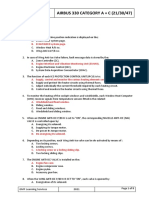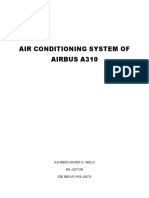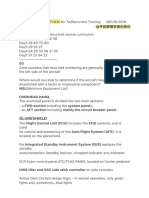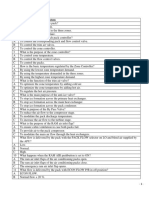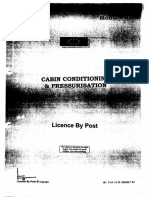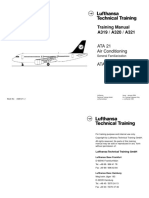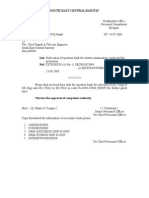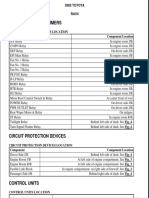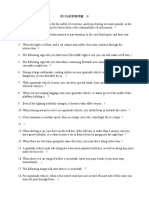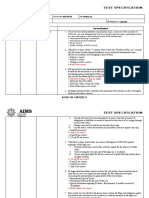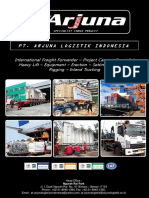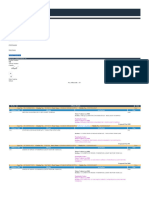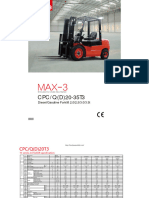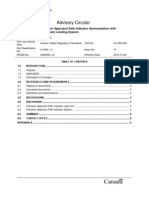A320 DSC-21
AIR CONDITIONING-PRESSURIZATION-VENTILATION
TRAINING DEPARTMENT 1
�■ AIR CONDITIONING
The air conditioning system is fully automatic and provides
continuous air renewal and maintains a constant, selected
temperature in COCKPIT, 2 cabin zones on A320:
Air is supplied by the pneumatic system, via:
‐ Two pack flow control valves,
‐ Two packs,
‐ The mixing unit, which mixes the air that comes from the
cabin and the packs.
Temperature regulation is optimized via the hot air pressure
regulating valve, and the trim air valves that add hot air, tapped
upstream of the packs, to the mixing unit air.
In an emergency, a ram air inlet can provide ambient air to the
mixing unit.
Temperature regulation is controlled by two Air Conditioning
System Controllers.
TRAINING DEPARTMENT 2
�A320
TRAINING DEPARTMENT 3
�AIR CONDITIONING PACK
The two packs operate automatically and independently of each other. Pack
operation is controlled by air conditioning system controller signals.
Warm pre-conditioned bleed air enters the cooling path via the pack flow control
valve, and is ducted to the primary heat exchanger.
Then, the cooled bleed air enters the compressor section of the air-cycle machine
and is compressed to a higher pressure and temperature.
It is cooled again in the main heat exchanger and enters the turbine section, where it
expands and, in expanding, generates power to drive the compressor and cooling air
fan.
A by-pass valve is used to adjust pack outlet temperature
TRAINING DEPARTMENT 4
�PACK FLOW CONTROL VALVE
Regulates the air flow in accordance with signals received from the pack controller.
In the absence of air pressure, a spring keeps the valve closed.
The valve closes automatically in case of pack overheating, engine starting, operation of the
fire or ditching pushbuttons, any unclosed doors at engine start, or insufficient upstream
pressure.
The valve is controlled from the AIR panel.
MIXER UNIT
This unit mixes cold fresh air from the packs with the cabin air being recirculated through
recirculation fans. The mixer unit is also connected to the emergency ram air inlet and the low
pressure ground inlets.
TRAINING DEPARTMENT 5
�RAM AIR
An emergency ram air inlet ventilates the cockpit and cabin, if both packs fail.
The emergency ram air inlet valve is controlled by the RAM AIR pb on the AIR COND panel.
This pushbutton opens the ram air valve, provided that ditching is not selected.
The outflow valves open about 50 %, provided that they are under automatic control and ΔP is less
than 1 PSI.
They do not automatically open if they are under manual control, even if the ΔP is less than 1 PSI.
If ΔP is greater than 1 PSI, the check valve, located downstream the ram air door, will not open. No
airflow will then be supplied.
TRAINING DEPARTMENT 6
�■ PRESSURIZATION
In normal operation, pressurization control is fully automatic. The flight crew can set
the system to operate automatically, semi-automatically, or manually.
The system consists of :
‐ Two Cabin Pressure Controllers (CPC)
‐ One Residual Pressure Control Unit (RPCU) , automatically despressurize the aircraft
in case of abnormal residual pressure on ground.
‐ Outflow valves: one for A320 , with actuators that
incorporate three motors (two for automatic operation, one for manual operation)
‐ One control panel
‐ Two independent safety valves,prevent cabin pressure from going too high (8,6 PSI
above ambient) or too low (1 PSI below ambient)
TRAINING DEPARTMENT 7
�In normal operation, cabin altitude and rate of change are automatically controlled from
FMGC flight plan data:
- Cruise FL, landing field elevation, QNH,
- Time to top of climb, time to landing.
In case of ditching, an override switch on the control panel allows the flight crew to close
the outflow valves, and all valves below the flotation line.
In case of dual FMGC failure, the crew has to manually select the landing elevation. The
cabin altitude varies according to field law.
In case of failure of both pressurization system auto-controllers, the manual back-up mode
is provided through the third outflow valve motor.
TRAINING DEPARTMENT 8
�CPC – Cabin Pressure Control
Two identical, independent, automatic controllers are used for cabin pressure control.
They receive signals from the Air Data Inertial Reference System (ADIRS), the Flight Management
and Guidance Computer (FMGC A320) , the Engine Interface Unit (EIU), the Landing Gear Control
Interface Unit (LGCIU), the Proximity Switch Control Unit (PSCU) and the pack flow control valves.
They perform the automatic cabin pressure control. They generate signals for the ECAM.
In automatic mode, one controller is active, the other is on standby.
TRAINING DEPARTMENT 9
�A320 Press Diagram
TRAINING DEPARTMENT 10
�■ VENTILATION
The ventilation system includes ventilation for:
‐ The batteries
‐ The lavatories and galleys
‐ The avionics
Battery ventilation
Provided by ambient air being drawn around the batteries and then vented directly
outboard via a venturi.
Lavatory and Galley Ventilation
Provided by ambient cabin air extracted by a fan and exhausted near the outflow valves.
TRAINING DEPARTMENT 11
�A320 AVIONICS
VENTILATION
TRAINING DEPARTMENT 12
�DSC 21 AIR CONDITIONING / PRESSURIZATION / VENTILATION VERIFICATION
1. The mixing unit, mixes air from:
A. Cabin
B. A/C Packs.
C. Cabin and Packs.
D. RAM Air in normal operation.
2. The two air-conditioning packs operate:
A. automatically and dependently.
B. automatically and independently
C. manually and dependently.
D. manually and independently.
TRAINING DEPARTMENT 13
�3. The outflow valves of the pressurization system are equipped with:
A. Actuators with two motors, one for automatic operation and one for manual operation.
B. Actuators with three motors, one for automatic operation and two for manual operation
C. Actuators with three motors, two for automatic operation and one for manual operation.
4. Battery ventilation is provided by:
A. Air being drawn around the batteries and then vented directly outboard.
B. Air being drawn around the batteries and then recirculated by the cabin fans.
C. Air being drawn around the batteries and then vented to the mixer unit.
TRAINING DEPARTMENT 14
�TRAINING DEPARTMENT 15
�TRAINING DEPARTMENT 16
�TRAINING DEPARTMENT 17

























